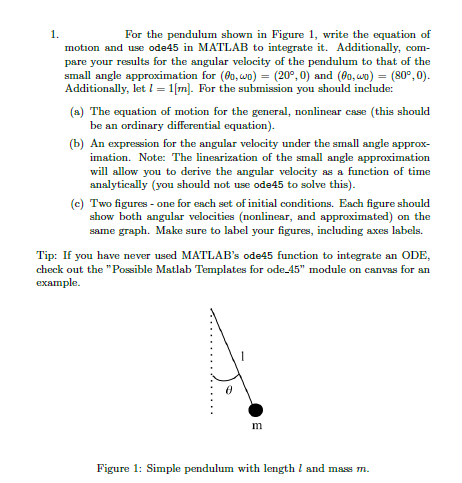1. For the pendulum shown in Figure 1, write the cquation of motion and use ode45 in MATLAB to integrate it. Additionally, com- pare your results for the angular velocity of the pendulum to that of the small angle approximation for (00, wo) = (20°, 0) and (60, wo) = (80°, 0). Additionally, let l = 1[m). For the submission you should include: (m) The equation of motion for the general, nonlinear case (this should be an ordinary differential equation). (b) An expression for the angular velocity under the small angle approx- imation. Note: The linearization of the small angle approximation will allow you to derive the angular velocity as a function of time analytically (you should not use ode45 to solve this). (c) Two figures - one for ench set of initial conditions. Ench figure should show both angular velocities (nonlinear, and approximated) on the same graph. Make sure to label your figures, including axes labels. Tip: If you have never used MATLAB's ode45 function to integrate an ODE, check out the "Possible Matlab Templates for ode.45" module on canvas for an еxample. Figure 1: Simple pendulum with length I and mass m.
1. For the pendulum shown in Figure 1, write the cquation of motion and use ode45 in MATLAB to integrate it. Additionally, com- pare your results for the angular velocity of the pendulum to that of the small angle approximation for (00, wo) = (20°, 0) and (60, wo) = (80°, 0). Additionally, let l = 1[m). For the submission you should include: (m) The equation of motion for the general, nonlinear case (this should be an ordinary differential equation). (b) An expression for the angular velocity under the small angle approx- imation. Note: The linearization of the small angle approximation will allow you to derive the angular velocity as a function of time analytically (you should not use ode45 to solve this). (c) Two figures - one for ench set of initial conditions. Ench figure should show both angular velocities (nonlinear, and approximated) on the same graph. Make sure to label your figures, including axes labels. Tip: If you have never used MATLAB's ode45 function to integrate an ODE, check out the "Possible Matlab Templates for ode.45" module on canvas for an еxample. Figure 1: Simple pendulum with length I and mass m.
Related questions
Question
I am just looking for the solution of the theoritical part. I will take care of the portion that requires usage of Matlab software.

Transcribed Image Text:1.
For the pendulum shown in Figure 1, write the equation of
motion and use ode45 in MATLAB to integrate it. Additionally, com-
pare your results for the angular velocity of the pendulum to that of the
small angle approximation for (80, wn) = (20°, 0) and (60, wn) = (80°, 0).
Additionally, let l = 1[m). For the submission you should include:
(a) The equation of motion for the general, nonlinear case (this should
be an ordinary differential equation).
(b) An expression for the angular velocity under the small angle spprox-
imation. Note: The linearization of the small angle approximation
will allow you to derive the angular velocity as a function of time
anslytically (you should not use ode45 to solve this).
(c) Two figures - one for esch set of initial conditions. Each figure should
show both angular velocities (nonlinear, and approximated) on the
same graph. Make sure to label your figures, including axes labels.
Tip: If you have never used MATLAB's ode45 function to integrate an ODE,
check out the "Possible Matlab Templates for ode.45" module on canvas for an
example.
m
Figure 1: Simple pendulum with length I and mass m.
Expert Solution
This question has been solved!
Explore an expertly crafted, step-by-step solution for a thorough understanding of key concepts.
This is a popular solution!
Trending now
This is a popular solution!
Step by step
Solved in 5 steps
